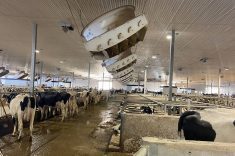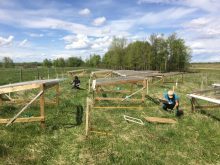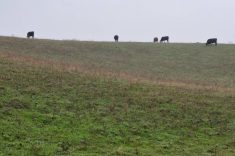Veterinarians warn that the dry start to the season may come back to roost when producers start pregnancy checking this fall.
Why it matters: Poor winter rations followed by poor pastures may mean a hard calving season next year.
Dr. Carl Reesink, of the Fisher Veterinary Clinic in Fisher Branch, says he is worried about poor conception rates, given the general lack of feed and forage.
“We’re expecting a bit of a hit in terms of reproduction, because pastures were low and cattle came onto pasture a little on the thin side,” he said. “You now have to remember that we’re faced with two consecutive years of tight groceries and, if the groceries aren’t there, then Mother Nature decides to slow down on reproduction.”
Read Also

Pig transport stress costs pork sector
Popular livestock trailer designs also increase pig stress during transportation, hitting at meat quality, animal welfare and farm profit, Agriculture and Agri-Food Canada researcher says
Energy requirements may have fallen below what is needed for cows to begin cycling, concerned veterinarians warn.
The Beef Cattle Research Council suggests that cows with a body condition score of two could take 88 days between calving and first heat, almost a month more than those with a score of three. Cows with a score of two have only an 80 per cent conception rate, compared to a 94 per cent conception rate for cattle that rate a three out on the five-point body condition score scale.
Poor nutrition also heralds more stillbirths and abortions — a one-point drop from a condition score of three increases the risk of stillbirths from 2.7 to 8.2 per cent and abortions from 1.6 to 2.5 per cent — and lowers colostrum quality, according to the research council.
Dr. Nathan Erickson of the Western College of Veterinary Medicine says he is, “kind of living in fear,” of the coming fall.
Many animals going out to pasture this spring were already on the cusp of not getting enough energy, he said during a presentation at Ag in Motion near Langham, Sask., this month.
The calving season may also shift, even if cows do conceive, veterinarians say. Erickson warned that nutrient stress might see cows bred in the second cycle rather than the first.
Reesink shares that concern.
“The calving season might be prolonged,” he said. “In anticipation of poor conception rates, producers may decide not to pull the bulls as early as they normally would.”
That will come with its own issues, such as increased labour, and a prolonged calving season may also have implications for disease control, he added.
The delay may also hit at the farmer’s bank account. Calves born out of a cow bred in the second cycle will have at least 21 fewer days to grow and will, on balance, be 30-40 pounds lighter when it comes time to market, Erikson said.
The delayed breeding season is of concern for producers who planned to prioritize their cull by tightening the breeding season and selling off the back end cows that remained open.
“That can be a good thing, for sure, because then you’re getting rid of some of your genetically poor cattle as well — that are calving in those later cycles,” Erickson said, although he cautioned that those producers should be prepared for an even higher-than-expected open rate come fall as cattle that were already bred in the second cycle get pushed yet further back.
The farmer may get a better herd out of the practice, Erickson said, although Reesink was concerned with the strategy.
An early pregnancy check will be critical in those cases, Reesink said.
Most, however, will go the other way and will drag out the next calving season, he thought.
Manitoba Agriculture was already raising the alarm on conception rates as of spring 2019.
In March, provincial livestock specialists urged producers not to skimp on nutrition, even if it meant buying more feed. At the time, producers were feeling the strain as winter feed rapidly dwindled, pastures failed to green, and prices remained high on what little feed was available for sale.
The conception concern is not universal in the province.
Dr. Catherine Clemence of the Russell and District Veterinary Clinic says she is not worried.
“We’ve had rain here, so the pastures are coming well now. I don’t think that will be a huge consideration,” she said, adding that hay crops are still lackluster, but grasses are growing vigorously.
“They should get bred, it’s just trying to find enough feed to keep them all winter that will be the issue,” she said.
Manitoba got some needed downpours in July. Most of agricultural Manitoba saw anywhere from 40 to 96 millimetres of rain this month according to Manitoba Agriculture’s Rain Watch. In many cases — such as the 40 to 66 millimetres reported in the Interlake — rain from those sporadic storms outweighed the previous three months combined.




















